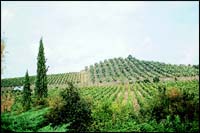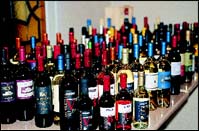


 Vineyards, Wineries Of Italy
Vineyards, Wineries Of ItalyLike a guided tour through the pages of Wine Spectator, discovers UpperCrust. |
|
We spent a day at three great wineries near Verona : Zonin, Pasqua, and Masi. Zonin is the largest privately owned wine making establishment in Italy, with vineyards all over Italy and Sicily. The owner president Gianni Zonin himself received us. His export director took us around the Zonin museum of old casks, wine presses, farming implements, a fabulous collection of corkscrews, all looking like medieval instruments of torture, but in fact used for the making and drinking of wonderful wine. He showed us how the grapes were crushed and the wine filtered (it was after all harvest season). Then we were treated to a fabulous lunch in the Zonin director's lunch room, with several executives joining us. Zonin makes a huge range of good to very good wines, but none that are great.
They served us Berengario and Acciaiolo which they said were among their best wines. I preferred the former, while most others liked the latter. Berengario is a unique red wine, grown near the Adriatic coast, and deliberately made to taste like a very good Bordeaux wine. I quote: �The noble Berengario, Duke of Friuli and first king of Italy, brought peace and well-being to his realm, making his rule one of the happiest periods in its history�' A millennium later, Zonin paid homage to that great monarch by dedicating to him a wine that is no less aristocratic, made from Cabernet Sauvignon and Merlot grapes grown in the Aquileia zone of Friuli and patiently matured in barriques of Allier oak (from the forests of the Troncais region of France).
Accaiolo is more like a Super Tuscan: 60 per cent Sangiovese, 40 per cent Cabernet Sauvignon. It is named after the Acciaioli family who built a castle, in the 15th century, in the Pian d' Albola, in the Chianti region near Siena. The Zonin family owns this estate now, where it makes this excellent wine. We ended our memorable visit with a rare tasting of Gianni Zonin's grappa, made in very limited quantities, and reserved for his close friends and family, as the label in Zonin's own hand writing says. Incidentally, Aman Dhall of Brindco is Zonin's representative in India, and you can buy your Zonin wines from him. (Tel:011 6920587 Fax:011 6316618 e-mail: [email protected]). Our next stop was the winery of Pasqua. It was founded in 1925 by three brothers, and is now run by the second generation. It is still privately owned by the original founders' families. They produce as many as 18 million bottles of good wine, some of it great, from over 1,000 hectares of the finest vineyards in the Veneto region. The very charming and efficient lady director of exports gave us a tasting of their excellent Valpolicellas and their great Amarones, especially the Villa Borghetti. Amarone is unique, a most unusual brand of wine, made from the Corvina, Molinara, and Rondinella grapes. These varieties grow only in the lush hills around Verona. The grapes are laid out to dry in the sun, a process as old as the Romans, and called 'appasimento' and then vinified. Amarones are big massive wines which go best with game, and earthy peasant cooking, i.e. with strongly flavoured foods. Excellent with tandoori chickens and kebabs. The wines have been made for only 50 years, but really hit the big time in 1990, when its vintage was superlative. Now Amarone has taken its rightful place together with the best Barolos, Barberescos, Super Tuscans, Brunello di Montalcinos,as being one of the best red wines in Italy, if not the world.
We met the present Count, Pieralvise Serego Alighieri, tall and taciturn, most elegant and aristocratic, the last of the family tree (he has two daughters, no sons), and fell in love with him and his estate. You can stay here in one of his eight apartments at most reasonable prices. The romantic Lago di Garda is only a few miles away. This is where to go if you want peace and quiet, and to meditate and write (though they haven't produced a poet of note in the 750 years since Dante by the Count's own admission). He runs a lovely little shop selling his olive oil, jams, marmalades, honey, grappa, balsamic seasoning and special Canaroli rice, and of course his wines, which are made by Masi. He gave Farzana and me gifts of chestnut honey and blackcurrant confiture, and I bought his olive oil and his Amarone. I've kept these for a special Dante evening in the not too distant future.
Masi makes splendid wines, Amarones and Valpolicellas and Reciotos and Bardolinos and Campofiorinin, but so do other winemakers. What Masi does make, which is unique in the whole wine making world, are two wines called Toar and Osar. Over dinner that night in Verona, the owner and president of Masi, Sandro Boscaini Masi, gave Farzana and me a tasting of these rarest of all wines. They use the oldest wine grape variety known to humanity, Oseleta, rediscovered and replanted by Masi as a personal passion. There is no point describing these fabulous wines. It is most unlikely that you will get to taste them.
If there is one place I want to go back to in Italy, it is to Count Serego Alighieri's estate, spend a few days wandering around Lake Garda during the day, visiting vineyards and wineries, and olive oil makers, eat in little trattorias, and return at night to drink fabled wines in the company of Dante's direct descendant (hopefully accompanied by someone I love). The estate is only 20 minutes from Verona, and Venice is just over an hour away by train or car. If this isn't your idea of paradise what is?
Tuscany is known throughout the world as a cradle of great wines and Chianti Classico is its pulsating heart. The millennial winemaking tradition of the zone together with the jealous preservation of the environment makes the tasting of its wines a real journey through Italian culture and taste, an unique experience. The complex flavour of a great Tuscan wine conceals an ancient culinary tradition. A vast variety of savours combines perfectly with the fragrances of the wines and the beauty of the landscape. Because of the genuineness and richness of the products of the Chianti Classico zone, some say, bread needs no salt. "Thou shalt have proof how savoureth of salt/the bread of others" (Dante Alighieri, Paradise, XVII).
Super Tuscans: These are the revolutionary wines being made in Tuscany during the past 40 years. Usually a blend of Sangiovese and Cabernet Sauvignon grapes, they defy all appellation controls in Italy, and are some of the country's most expensive and sought after wines. The greatest of all Super Tuscans was the 1985 Sassicaia (virtually unavailable). But my choice now are the 1990 and 1997 vintages of Solaia, Tignanello, Ornellaia and of course Sassicaia. Farnito Carpineto is tremendous value for money, and my favourites aside from the legendary wines mentioned already. These wines are full bodied, complex and fruity in character, with a round, supple tannin structure and a long, persistent, clean finish. Despite their approachability upon release, these red wines are designed for long cellar aging of 20 years or longer. The Solaia 1997 was chosen by the Wine Spectator as the greatest wine in the world made in 1997. Montalcino, one of Italy's premier wine towns, produces one of that country's most expensive wines: Brunello di Montalcino. Brunello is famous for its austerity and extraordinary aging potential, but in recent years vinification techniques have lightened up; today's Brunellos are more notable for their rich, ripe, and similar attractive qualities. The Biondi Santi family originally put the region on the map with their consistent efforts dating from 1842, when Brunello was first noted as a distinct subspecies of Sangiovese in the family vineyards in Greppo, southeast of Montalcino. Much of the reputation of these powerful wines is built on the extraordinary cellaring ability demonstrated by Biondi Santi's wines over the ages.
Vineyards are typically located on steep slopes ranging up to 1,500 feet, giving the Brunello slow ripening conditions essential for its sturdy character. Unlike the vogue with other Tuscan wines, extended wood aging is an essential part of the wines' character, with two years being obligatory. In 1998 this was changed from a three and a half year period in wood, as some critics had asserted that in weaker vintages, the time spent in wood dried out the wine prematurely, reducing its ability to age. Nonetheless, the best producers of Brunello consistently produce some of Italy's finest wines. Within the same geographical boundaries as the DOCG region exists a declassified DOC called Rosso di Montalcino. These wines can be made from the same fruit as that used for Brunello di Montalcino, but in practice are often from younger vines, and always vinified and aged in a manner that allows them to be consumed younger. Brunello is an expensive wine; this tends to be the first thing people talk about when discussing it � is it worthy of the price tag? The answer is a resounding 'Yes', especially from years such as 1995, and from producers such as Castello Banfi, Biondi-Santi, Angelo Gaja's La Pieve di Santa Restituta (Rennina), and Col D'Orsa. We visited the extraordinary Banfi winery, and were treated to some excellent wines accompanying a superb lunch.
The menu is worth reproducing :
If you are very lucky, after such wine tastings and food, you can stay in one of the few apartments they let out to visitors. It is so beautiful you may not want to leave !
|

Home Page
About the mag
Subscribe
Advertise
Contact Us
 Pasqua's range of Amarone wines is truly excellent; so is Dal Forno's; and Allegrinis. Then of course there is Masi, where we headed next. The legendary British wine writer, Hugh Johnson, calls Masi the 'touchstone for Verona wines', and quite rightly. The name Masi derives from 'Vaio dei Masi', a little valley acquired in the late 18th century by the Boscaini family, which retains ownership to this day. Among the vineyards that Masi manages is the most historic estate in all of Italy, which has belonged to the noble Serego Alighieri family, in an unbroken line of 20 descendants of the greatest of all Italian poets, Dante Alighieri, author of the classic 'Divine Comedy'. He had lived in this region for many years in exile, and his son Pietro bought the vineyards here in 1353.
Pasqua's range of Amarone wines is truly excellent; so is Dal Forno's; and Allegrinis. Then of course there is Masi, where we headed next. The legendary British wine writer, Hugh Johnson, calls Masi the 'touchstone for Verona wines', and quite rightly. The name Masi derives from 'Vaio dei Masi', a little valley acquired in the late 18th century by the Boscaini family, which retains ownership to this day. Among the vineyards that Masi manages is the most historic estate in all of Italy, which has belonged to the noble Serego Alighieri family, in an unbroken line of 20 descendants of the greatest of all Italian poets, Dante Alighieri, author of the classic 'Divine Comedy'. He had lived in this region for many years in exile, and his son Pietro bought the vineyards here in 1353.